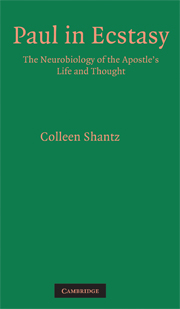Book contents
- Frontmatter
- Contents
- Acknowledgments
- Dedication
- Introduction
- 1 What Ecstasy? An Assessment of the Misregard
- 2 Paul's Brain: The Cognitive Neurology of Ecstasy
- 3 Paul's Voice: Parsing Paul's Ecstatic Discourse
- 4 Paul's Practice: Discerning Ecstasies in Practice
- 5 The Whole Paul: A Short Course in (Nondeterministic) Complexity
- Bibliography
- Index of Ancient Sources
- Index of Modern Authors
- Subject Index
1 - What Ecstasy? An Assessment of the Misregard
Published online by Cambridge University Press: 06 January 2010
- Frontmatter
- Contents
- Acknowledgments
- Dedication
- Introduction
- 1 What Ecstasy? An Assessment of the Misregard
- 2 Paul's Brain: The Cognitive Neurology of Ecstasy
- 3 Paul's Voice: Parsing Paul's Ecstatic Discourse
- 4 Paul's Practice: Discerning Ecstasies in Practice
- 5 The Whole Paul: A Short Course in (Nondeterministic) Complexity
- Bibliography
- Index of Ancient Sources
- Index of Modern Authors
- Subject Index
Summary
“As a rule,” said Holmes, “the more bizarre a thing is the less mysterious it turns out to be. It is your commonplace featureless crimes which are really puzzling.”
– Arthur Conan DoyleTo an imagination used to the perspectives of dignity and glory, the naked gospel scheme seems to offer an almshouse for a palace.
– William JamesReligious ecstasy is rarely taken up as a category of Pauline studies and even less often as a window into the historical character of Paul himself. This is not to say that ecstatic elements in Paul's letters have gone wholly unnoticed, but rather that they have not typically been addressed as an aspect of his life and thought. Among the labels applied to Paul – apostle, convert, Pharisee, apocalyptic, even tentmaker – that of ecstatic is seldom used. In fact, it is often forcefully resisted. This chapter examines that resistance both within Pauline studies in particular and within the larger culture in general. Why the extraordinary effort to avoid the ecstatic in Paul's life? What has, in benign form, prevented people from attending to this feature and, in more tendentious forms, motivated them to work so hard against the more obvious meaning of the text? On occasion, the misregard of ecstasy seems significantly more “bizarre” than the fact that Paul experienced it; yet, more often, the misregard is merely the product of habits of seeing – where we look, the perspective from which we look, and the lenses that focus our attention.
- Type
- Chapter
- Information
- Paul in EcstasyThe Neurobiology of the Apostle's Life and Thought, pp. 20 - 66Publisher: Cambridge University PressPrint publication year: 2009



